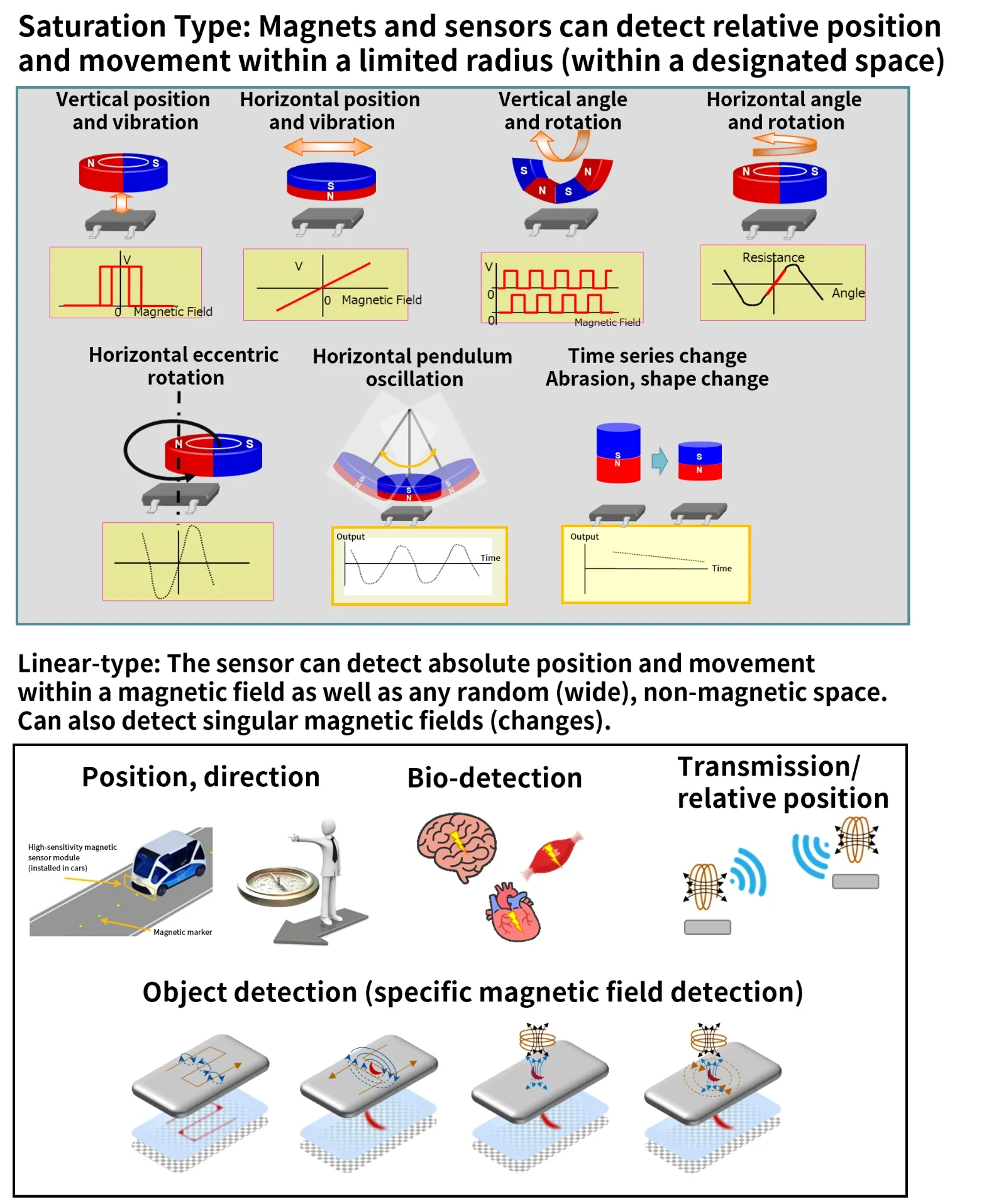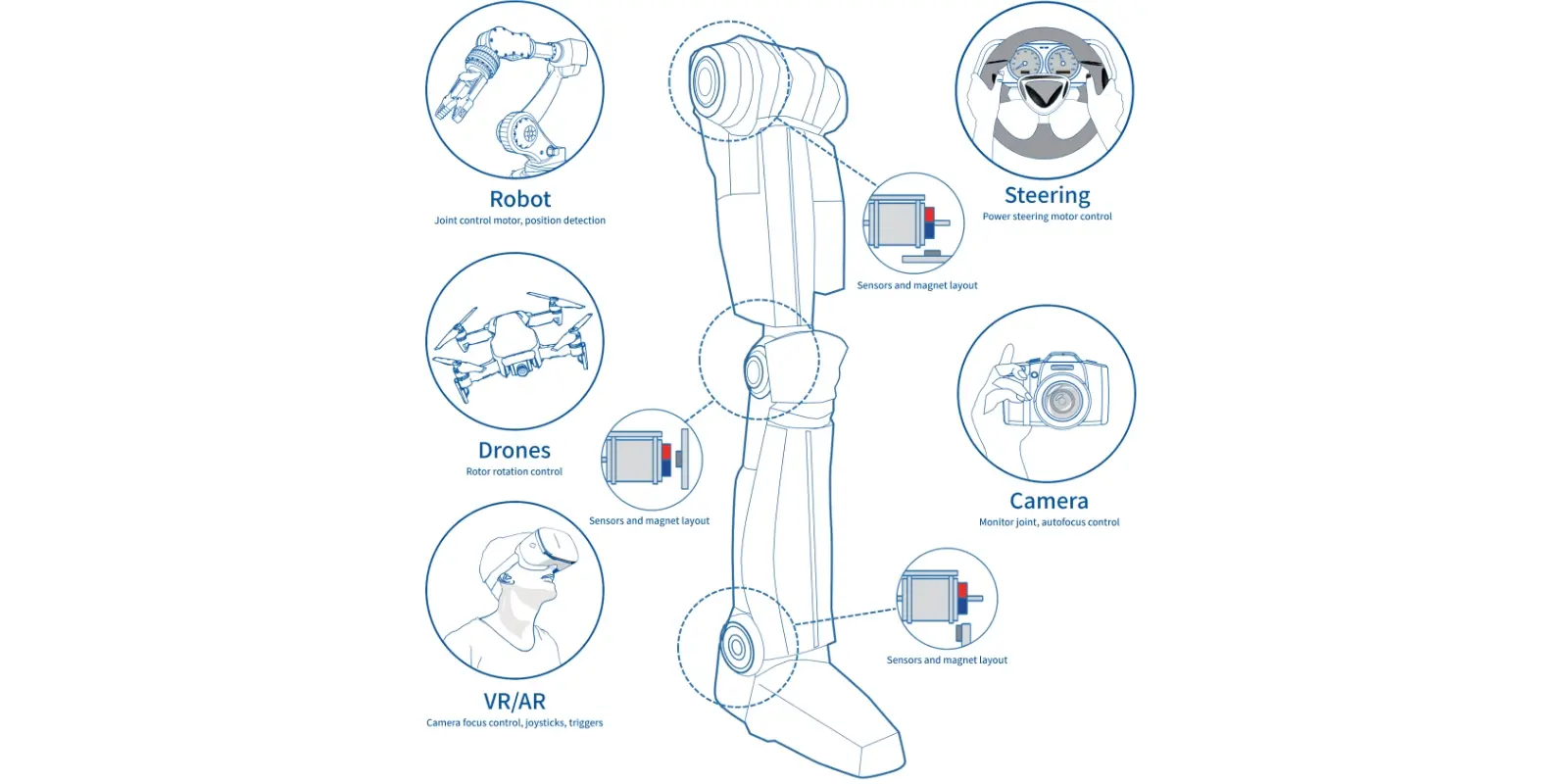Magnetism Technology
Contact-less sensing by magnetism: Creating the Future of Automobiles and Devices
Magnetic sensors can detect proximity, rotation, and position without contact using the unseen power of magnetism. The sensor is highly durable, and there is no contact wear because it can sense objects without touch. From automobiles, smartphones, and home electronics to computers, this technology has a wide range of applications and is becoming an essential part of everyday life.
Alps Alpine has been developing magnetism technologies for many years. Our development ranges from the sensor itself to its modularization, and we adapt them for a diverse array of uses.
Research and Development of both magnetic saturation and linear sensors
Alps Alpine began developing its magnetism technologies to make magnetic heads that could both read and write audio data. We would go on to use those heads in hard disk drives, and now our magnetic sensors are the core of many products in our lineup. As of today, we’ve been in the business of magnetism technology for over 30 years.

Magnetic sensors are broadly classified into "saturation-type" and "linear-type" according to the detection method of the space affected by magnetism.

Saturation is growing into a type of detection used mainly with magnets. Its performance is not easily affected by other external forces, and it can measure with high precision even around causes of errors, such as the presence of other magnetic fields. An example of a saturation-type magnetic sensor is one that detects whether a laptop computer is open or closed. A magnet and a magnetic sensor are installed in the body and display to detect the proximity to determine whether it is open or closed.
Linear detection does not require a magnet and has a superior sensitivity that allows it to measure in magnetized spaces. An example of a linear-type sensor can be found in orientation detection in map apps on smartphones. Direction is determined by reading the surrounding magnetic fields. Alps Alpine has strong technological capabilities in producing both types of sensors and is working to create products with them.
Saturation sensors that support the evolution of automobiles
One of Alps Alpine’s strengths with magnetism technology is its use of giant magnetoresistance (GMR) elements in both the saturation and linear type sensors. GMRs can make very accurate magnetic measurements because they are highly sensitive and can detect changes in spaces that are covered in minute magnetic fields. Also, another advantage is that it features stable sensing in extremely large magnetic fields. Moreover, GMR is also energy efficient, making it ideal in battery-powered devices.
Alps Alpine’s saturation-type sensors are widely used in automobiles. Conventionally, rods that transmit rotation and wires that transmit how much the pedals have been pressed have been in use, but the wear and tear over time on these parts has been a problem.
Non-contact magnetic sensors can prevent the wear on these parts, maintain their functionality, and extend the life of these products.
Today’s automobiles generally have anywhere from 50 to 100 magnetic sensors in them. In addition to the above-mentioned steering wheels, pedals, and other controls, Alps Alpine is developing products that can be used in central mechanisms such as traction motors and oil pumps.
We predict that saturation-type sensors will be used in other areas such as home appliances and game console controllers in the future. Simple, low-cost, sensors with lower sensitivity than GMR had been widely used for on/ off and angle detection. In recent years, however, more advanced standards are required for the sensors mounted on these devices as needs become more segmented and the devices themselves evolve.

Alps Alpine has a long record of putting magnetism technologies to practical use. We propose solutions in the field of GMR with small, highly sensitive, highly precise, saturation-type sensors that have high functionality and are resistant to outside forces.
Linear sensors that contribute to high functionality in smartphones
Alpine does a great deal of work on highly magnetic, linear-type sensors for installation in smartphones as orientation sensors. These high-precision sensors can detect minute magnetic changes in a space, allowing them to precisely detect the location and measure change.
Also, another similar product to be released for smartphones is a magnetic sensor for the camera lens. The trend in smartphone camera lenses is toward larger aperture sizes. Along with actuators that control zoom and image stabilization, magnetic sensors are playing an increasingly larger role. Alps Alpine works to develop actuators along with magnetic sensors to meet the increasingly sophisticated needs of smartphones.
In addition, as with our saturation-type sensors, our linear-type sensors are widely used in the automotive field. Electric vehicles, which are becoming increasingly common, take advantage of the low-noise characteristics of GMR. We are currently building battery management systems that can capture small magnetic patterns and weak fluctuations even when the vehicle is in spaces with varying voltages and magnetism that may affect its motion.
Alps Alpine’s magnetism technology has led to the development of saturation-type and linear-type sensors. The saturation type is less susceptible to various external forces and can measure with high precision even in the presence of other magnetic fields, while linear-type sensors have superior magnetic sensitivity. Both have been developed to take advantage of their strengths.
We will continue to develop magnetism technology and create new possibilities for magnetic sensors.